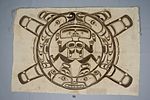mawił (Dance Screen)
About this object
History of use
Dance screen or dance curtain. Large pieces of fabric, painted with the Tsetseka spirit of the dancing house, replaced earlier painted cedar plank walls. Each dancing house had its own painted curtain which was used as a screen to close off the rear part of the house, providing a space for masks and other ceremonial objects to be placed in readiness for the dancers. This space was strictly forbidden to uninitiated people. Entrance of the dancers was from the right of the screen, and exits were from the left.
Narrative
Adam Dick confirmed that this curtain was painted by Arthur Shaughnessy (his father’s uncle). He said he watched Shaughnessy paint one side of this curtain in 1936 or 1937 in the bighouse at Kingcome and then fold it for Mr. Hall (Charlie George) to paint the other half. Jimmy Dick was Adam Dick’s father.
Cultural context
ceremonial
Iconographic meaning
Sisiutl, the mythological double-headed serpent, is closely associated with Winalagalis, the war spirit. Sisiutl can be ridden and rowed like a canoe, its flesh is impervious to spears, it can inflict instant death at a glance, and can cause any enemy looking at it to turn to stone with all his joints turned backwards. Sisiutl is frequently depicted on ceremonial objects, including dance aprons and coppers.
Specific techniques
Commercial cotton fabric painted black, either with water pigment, mud and charcoal, or commercial paint.
Physical description
Large, ceremonial dance screen. Painted with a circular design in black on ecru-coloured cotton. Split image of a sisiutl encircling a central human figure. Cord for hanging attached along the upper edge.
